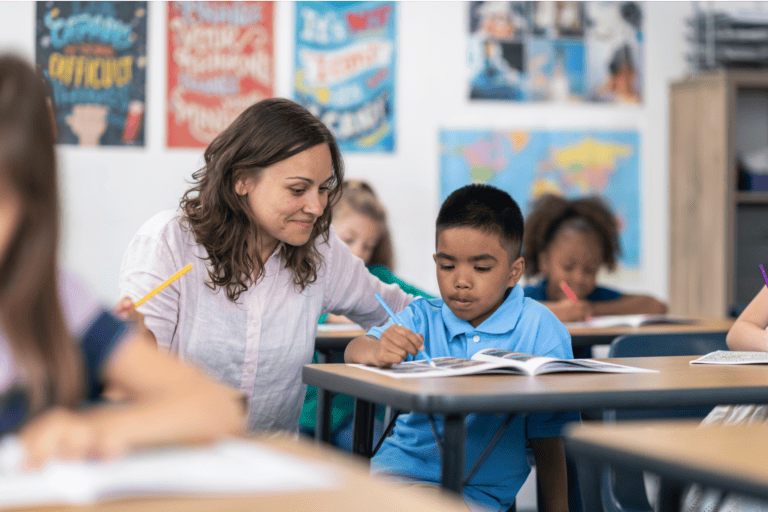Starting with the Student: A Conversation with Emily Weinstein
Dr. Emily Weinstein is a Principal Investigator at Harvard’s Project Zero, a lecturer at the Harvard Graduate School of Education, and the founding Co-Director of the Center for Digital Thriving at Harvard Graduate School of Education. What follows is a conversation between Emily and R.E.A.L. ® Founder Liza Garonzik. This conversation has been lightly edited for clarity.
Liza: Welcome, Emily, to the R.E.A.L.® blog! We’re so excited to speak with you today.
Emily: Thank you for your excitement about this work and for interviewing me.
Liza: We’ve been evangelists of your work – captured so powerfully in your book Behind Their Screens – for a while. Could you tell us about your path into education and, now, research? What made you interested in kids’ experiences on their screens?

Emily: I don’t know how I could not be interested in this topic! My background is in human development and education, with a focus on adolescent psychology. I’ve been researching adolescents’ experiences with social media and smartphones for over a decade now. These technologies are huge parts of adolescents’ everyday lives, and I’ve had an accidental front-row seat to a lot of the changes, because I’ve been doing this research since 2011, talking with thousands of teens and working with many different schools and communities all along the way.
I watched these shifts: to teens suddenly having social media accounts and smartphones, and to things like group chats becoming huge parts of their everyday lives.
Liza: Tell us more about that – how are group chats becoming so entrenched in kids’ lives?
Emily: I’m reminded of a teen who shared this idea that group chats are like the new middle school lunchroom – but there is no bell after 30 minutes. This is really around-the-clock, with all of that same closeness and the things that we love about being in a lunchroom with friends hanging out. But also, if you remember the middle school lunchroom, there are so many tricky aspects – anxiety around what table you sat at, what it meant, what you said and how others responded. In this case, teens tell us how the group chats you’re in (or not in!) have real implications for who your friends are and how you fit into the social world. There’s this sense of self-consciousness that can come along with it – but also a second- and third-guessing of yourself. Like, what if you send a message and no one replies, but then someone else sends a message and a few people like it right away?
All of this to say: I am totally fascinated by the ways that technology is intersecting with and transforming adolescents’ experiences of their development, identities, relationships, sense of self, and sense of the world that they are growing up in. Media headlines so often give us this sense that all kids are having the same, terrible experience with all technology. The reality is so much more complicated.
I’m not scared of the complexity; I’m curious about it. I think there’s a lot of power in getting super curious about kids’ experiences. I want to help the public really understand how it feels for kids to grow up with today’s technologies, so we can all think more productively about what different kids need to thrive.
Media headlines so often give us this sense that all kids are having the same, terrible experience with all technology. The reality is so much more complicated.
Emily Weinstein
So often, adults are intimidated by this topic because we don’t know what a snap map is or how Fortnite works. There’s a sense that, “I don’t even know what to do, or what to say, or how to help.” But I also know that kids really need us, and you don’t actually have to know anything about Fortnite or a snap map in order to be the kind of supporter that kids really do need. Curiosity and research are keys to bridging the gaps between adults and kids.
Liza: Yes, yes, YES! At R.E.A.L.® we are also proponents of a curiosity lens – we ask students to help us understand how face-to-face discussion feels different from on-screen. It’s easy to assume we know, but digital natives see the divide between on screen and “IRL” differently!
Your new project, The Center for Digital Thriving, is on a mission to catalyze new conversation about tech that is both critical and optimistic. So what is digital thriving? What is the role of teachers and schools in achieving it?
Emily: We started the Center because of this idea that everyone should be able to thrive in a world filled with tech. This feels essential, and we want to figure out how to get there. Honestly, we’re still figuring out exactly what that means – but we have some ideas.
Our team is completely obsessed with this idea that every kid should be able to thrive in a world filled with today’s technologies – that we need to shift the trends we’re seeing in mental health and well-being and make sure thriving is possible. This is going to require deeper understanding, new social norms, better policies, and intentional efforts in education – among other things.
In many ways, it feels like we’re in this moment where we’re on the cusp of figuring out what’s needed and what we’re willing to change. Imagine that cars have been invented, but we have not yet figured out speed limits, seat belts, driver’s ed, driver’s licenses, airbags, etc. So we’re in a position where every family has to make their own choice about when their kid is ready to drive a car – and they’re sending them into this car without knowing if it’s safe, if it’s working well, or if other drivers in the ecosystem are honoring rules of the road. It feels like there is a whole ecosystem of support and scaffolding around technology that is missing right now. As a society, we need to create that support and scaffolding to help us (and kids especially) live with technology, and tap its benefits without feeling constantly at risk. The burden on individual families and on kids is just too big right now.
As a society, we need to create that support and scaffolding to help us (and kids especially) live with technology, and tap its benefits without feeling constantly at risk.
EMily WEinstein
Right now there is too much burden on individual kids and parents and educators to try and correct problems that are literally created by design. To be clear, though, I don’t think creating this supportive ecosystem requires only policy and design changes – though I do think that’s going to be an essential piece of the path forward.
At the Center, one thing we’re trying to figure out is what kinds of research, resources, and ways of thinking will help us all as a society move forward and be able to thrive with tech? What new social norms and policies do we need? How do we leverage the power of schools and teachers? I believe in the power of educators and schools to help build what we talk about as “digital agency.”
Liza: What is “digital agency”?
Emily: We think of digital agency as having meaningful intentionality and control in the realm of tech. There are a lot of ways that kids tell us that their very sense of agency is undercut by design features that make it really hard for them to self-regulate. Plus, social norms create a lot of pressure to participate with technology in certain ways that don’t feel optional. One thing we’ve been really interested in is how to empower agency, rather than just enforce rules that further erode agency. We think it requires skills (so you know what to do), literacies (so you understand what’s going on, including with things like algorithms that shape what you see), and dispositions (which shape the ways you think about tech, including your values, mindful awareness, and inclinations).
We think of digital agency as having meaningful intentionality and control in the realm of tech. There are a lot of ways that kids tell us that their very sense of agency is undercut by design features that make it really hard for them to self-regulate.
Emily Weinstein
Liza: Fascinating. Your book, Behind Their Screens, is a go-to footnote for us at R.E.A.L. We love how you asked thousands of students about their experiences on- and off-screen and sought to understand the kids’ perspectives. What did you learn about how on-screen interactions influence how they feel and experience life off-screen?
Emily: I learned that tech is an amplifier, but what it amplifies is different for different kids and in different moments.
Recognizing that tech doesn’t feel optional or low-stakes to teens – and thinking of it as an amplifier – can be helpful in getting us to tune into the question: what is tech amplifying for this particular kid in front of me right now? How is tech intersecting with their vulnerabilities? What are they struggling with right now? Is tech actually helping in some way? Is it a source of further stress or strain? And what does this tell me about what this kid might need in terms of intervention or support?
Liza: It might be too early in your work to tell, but are their research-backed interventions for helping kids thrive in a digital age? If so, what are they?
Emily: For those of us who are craving evidence-backed interventions right now, I am most inclined toward tracing connections to interventions that we know work, and not getting so hung up in the tech piece that we forget how much we know about supporting kids’ thriving and their well-being.
For example: we know tech can make it complicated to have really good face-to-face conversations when we’re distracted by notifications or the pull to our screens. There are evidence-based practices that we know support good conversations – and how to teach things like listening and focused attention and kind, clear communication. Another favorite, for me, is that we know social media can amplify thinking traps or cognitive distortions – like the idea that “everyone on my feed is happier than me.” So our team has been leaning on insights from CBT about cognitive distortions to teach teens about them.
We know tech can make it complicated to have really good face-to-face conversations when we’re distracted by notifications or the pull to our screens. There are evidence-based practices that we know support good conversations – and how to teach things like listening and focused attention and kind, clear communication.
Emily Weinstein
One powerful thing we can do is trace connections to the interventions that we know and really believe, so we’re actually helping to facilitate the transfer and the connections to tech. So, to go back to the “good conversations” example, it might mean during the very same lesson about good conversation but introducing, as part of the framing, how technology makes good conversations easier or harder, and why good conversations are even more important in a world filled with tech. We need to turn up the volume on the interventions that we know are research-backed and evidence-based for supporting the competencies, dispositions, mindsets, and skills that we know are especially important for kids in general – and especially so in a tech-filled world.
Liza: In your experience, what do you think are some mindshifts that can help us adults identify those interventions?
Emily: It’s been powerful for us to pivot from starting with tech to starting with the student. Often when we think about the digital age, there’s this instinct to start with tech: what is pernicious about the tech itself? Or, how are we going to deal with tech?
But when we start with the student and think about what the student needs, it really shifts our focus and attention. I think it also helps us kind of find the dry land when it feels like the tech is changing so fast.
Often when we think about the digital age, there’s this instinct to start with tech. But when we start with the student and think about what the student needs, it really shifts our focus and attention.
Emily Weinstein
That looks like thinking about what we know kids need to support their well-being, then thinking about how those things are potentially impacted by tech. Create space for student voices, recognizing that different kids will have different experiences. We really, really need to listen for understanding.
Liza: Exactly. Student voice has been so central to our work, too. It’s part of why we survey our students so often – to help reinforce that idea of starting with the student and ensuring that what we’re delivering matters to them.
What advice do you have for teachers in terms of something they could do in their classroom starting tomorrow that could make a difference for kids growing up in this screen-bound world?
Emily: So many! One simple activity that any teacher can do is to talk about values and then connect them to tech. I love the way that asking students about what they value and what they care about can lead into very different kinds of conversations about tech and our habits. One activity we’ve created that I love for this is a value sort. We have cards you can print and cut, so you can do it analog, or students can use our app to do it digitally with no extra supplies prep.
It’s really simple: first think about the values that are most important to you right now, then connect different values to tech. You can ask questions like, “how are different values supported or made harder by today’s tech?” or “How does living in a tech-filled world impact our values?”
I also love dot voting: print out pages with different values and have students put green dots on values they feel are supported by tech, and red dots on values that are made harder by tech. This is consistently an opener for such a rich conversation, and it’s a great lead-in to thinking about tech habits, too. What tech habits do we have that support our values, and what habits might we want to think about changing so we’re living more aligned with our values?
What tech habits do we have that support our values, and what habits might we want to think about changing so we’re living more aligned with our values?
Emily Weinstein
Liza: That’s such a great way to frame the conversation. Ok, last question! At R.E.A.L.®, we often think about in-person communication skills as a “hedge” or “insurance policy” against what we call the “digital infinity” facing our middle and high school students. If students feel seen, heard, and equipped to analyze relational dynamics in their off-screen life, they are more likely to engage thoughtfully and positively online — and seek help when they need it. We are thrilled to know that approach aligns to yours. The Center for Digital Thriving! Is there anything else you’d like to add that we missed?
Emily: Yes! I love that so much – truly, there’s so much wisdom in your approach and the idea of these skills as a hedge. I was just talking to an educator last week who remembered how the arrival of a smartboard in her classroom just felt like tech being thrust on her – and yet another thing she had to put on her to do list to figure out. Many teachers have probably had an experience like this: We show up and there’s a new technology, and there is an assumption that it’s better than previous ways of instruction, and the burden is suddenly on the educators to figure out how to use it and what they need to do and what their students might need, and it can feel really hard. It can feel like a chore – it’s yet another thing for us to do and figure out. Not to mention phones! Teachers didn’t decide to give students phones – parents did – but teachers now have this heavy burden of trying to manage them in their classrooms or implement policies.
The burden is on educators to figure out how to use [technology] and what their students might need, and it can feel really hard.
Emliy Weinstein
One thing our center is working on right now is how to support educators so that they can support their students around tech – getting teachers out of being stuck in that referee role and shifting into a role we know kids need educators to play, which is as coaches for digital life. We need our teachers to be able to move beyond just ‘blowing a whistle’ when kids have a phone out and they’re not supposed to – so teachers can actually be a coach for all the skills and dispositions that kids need. How do we help students practice the kinds of skills and boundaries that cultivate the literacies they need to be able to thrive in a world filled with tech?
My colleague Carrie James and I have been researching key pivots or mindshifts that educators can make to shift our knee-jerk reactions around tech in productive ways that also feel like a relief. So, the pivot from feeling only like a referee to thinking about what it looks like to be a coach; the pivot from starting with tech to starting with the student; the pivot from applying an abstinence model about tech to an agency model. We’re developing a PD resources right now around the idea of these different pivots, which will be available through our Center for Digital Thriving and Harvard Graduate School of Education.
Liza: That’s great, and we’ll link to those resources if readers would like to learn more about the Center and how they can learn from your work.
Emily: Thank you so much. Thank you for the opportunity to share some of this work – and thank YOU for all of the work that your team is doing, Liza! It’s so important and, as you said, also a critical “hedge” in the current moment.






